The Fundamentals: Why Tiny Changes Make a Big Difference
1. The Surprising Power of Atomic Habits
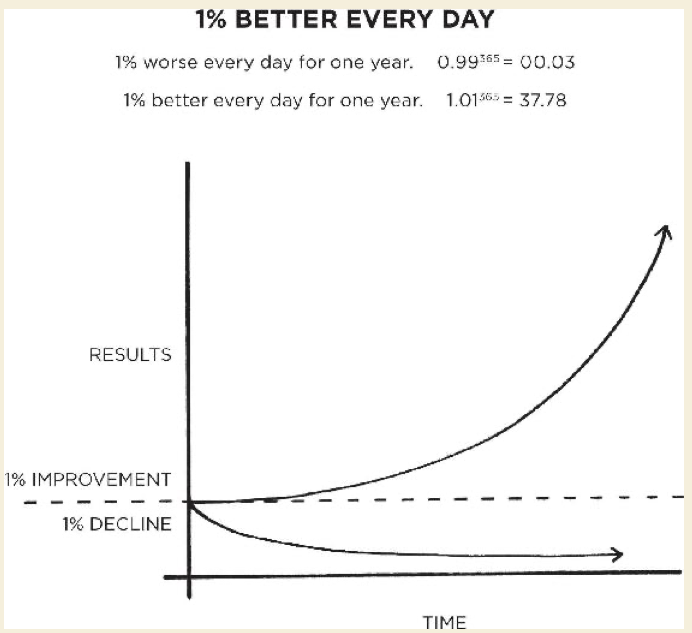
That said, it doesn’t matter how successful or unsuccessful you are right now. What matters is whether your habits are putting you on the path toward success. You should be far more concerned with your current trajectory than with your current results.
Your outcomes are a lagging measure of your habits. Your net worth is a lagging measure of your financial habits. Your weight is a lagging measure of your eating habits. Your knowledge is a lagging measure of your learning habits. Your clutter is a lagging measure of your cleaning habits. You get what you repeat.
Time magnifies the margin between success and failure. It will multiply whatever you feed it. Good habits make time your ally. Bad habits make time your enemy.
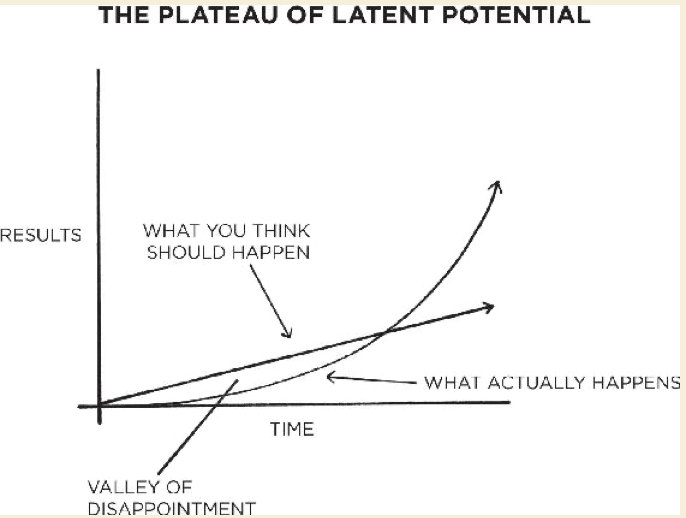
If you find yourself struggling to build a good habit or break a bad one, it is not because you have lost your ability to improve. It is often because you have not yet crossed the Plateau of Latent Potential. When you finally break through the Plateau of Latent Potential, people will call it an overnight success.
It is the human equivalent of geological pressure. Two tectonic plates can grind against one another for millions of years, the tension slowly building all the while. Then, one day, they rub each other once again, in the same fashion they have for ages, but this time the tension is too great. An earthquake erupts. Change can take years—before it happens all at once.
Forget about setting goals. Focus on your system instead. Goals are about the results you want to achieve. Systems are about the processes that lead to those results. Goals are good for setting a direction, but systems are best for making progress.
- Problem #1: Winners and losers have the same goals.
- Problem #2: Achieving a goal is only a momentary change.
- Problem #3: Goals restrict your happiness.
- Problem #4: Goals are at odds with long-term progress.
We think we need to change our results, but the results are not the problem. What we really need to change are the systems that cause those results. When you solve problems at the results level, you only solve them temporarily. In order to improve for good, you need to solve problems at the systems level. Fix the inputs and the outputs will fix themselves.
The purpose of setting goals is to win the game. The purpose of building systems is to continue playing the game. True long-term thinking is goal-less thinking. When all of your hard work is focused on a particular goal, what is left to push you forward after you achieve it? This is why many people find themselves reverting to their old habits after accomplishing a goal.
But atomic habits are not just any old habits, however small. They are little habits that are part of a larger system. Just as atoms are the building blocks of molecules, atomic habits are the building blocks of remarkable results.
2. How Your Habits Shape Your Identity (and Vice Versa)
Changing our habits is challenging for two reasons: (1) we try to change the wrong thing and (2) we try to change our habits in the wrong way.
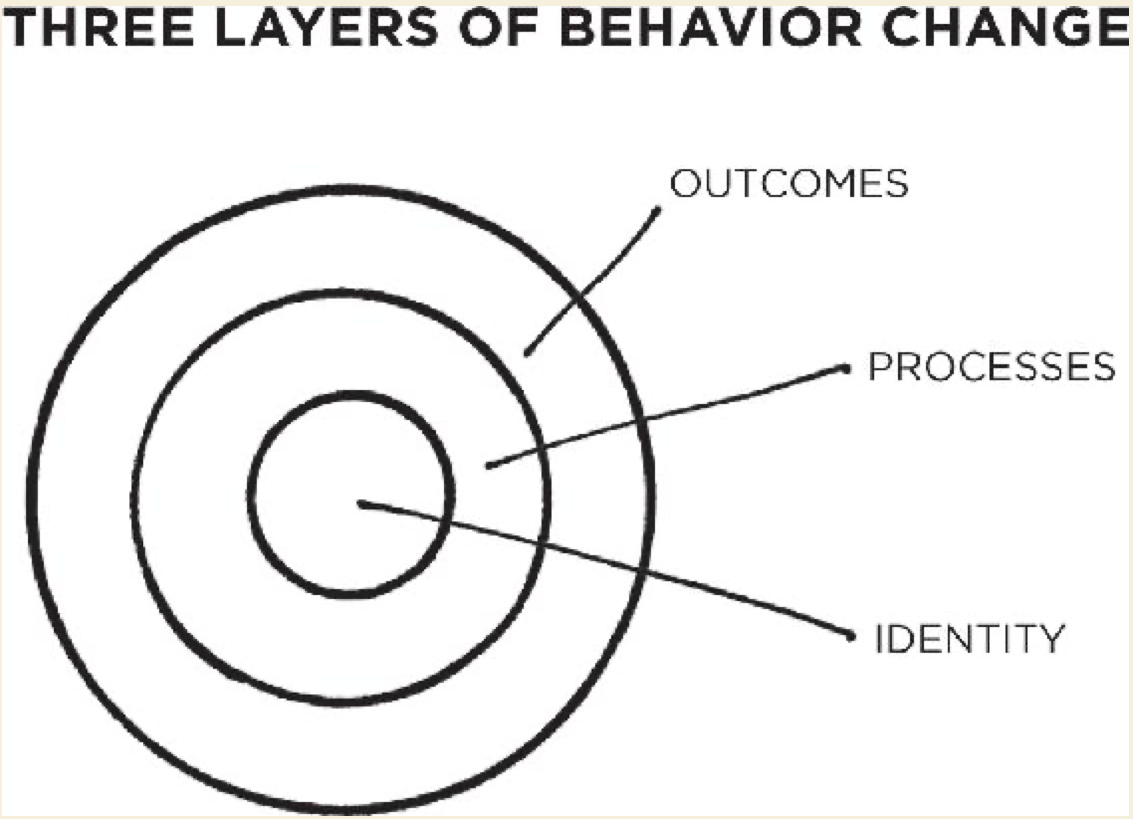
With outcome-based habits, the focus is on what you want to achieve. With identity-based habits, the focus is on who you wish to become.
Behavior that is incongruent with the self will not last.
The ultimate form of intrinsic motivation is when a habit becomes part of your identity. It’s one thing to say I’m the type of person who wants this. It’s something very different to say I’m the type of person who is this.
The more pride you have in a particular aspect of your identity, the more motivated you will be to maintain the habits associated with it.
I am proud of my fingernails.
I am proud that I get up early and don’t stay up.
True behavior change is identity change. Improvements are only temporary until they become part of who you are.
The goal is not to read a book, the goal is to become a reader. The goal is not to run a marathon, the goal is to become a runner.
Research has shown that once a person believes in a particular aspect of their identity, they are more likely to act in alignment with that belief. For example, people who identified as “being a voter” were more likely to vote than those who simply claimed “voting” was an action they wanted to perform. Doing the right thing is easy. After all, when your behavior and your identity are fully aligned, you are no longer pursuing behavior change. You are simply acting like the type of person you already believe yourself to be.
Find out the norms that I blindly attached to my identity.
- “I’m terrible with insisting good habits.”
- “I’m not good at methamatics.”
- “I cannot devote myself to research fully.”
- “I’m not good at speaking.”
When you have repeated a story to yourself for years, it is easy to slide into these mental grooves and accept them as a fact. In time, you begin to resist certain actions because “that’s not who I am.” Good habits can make rational sense, but if they conflict with your identity, you will fail to put them into action.
Becoming the best version of yourself requires you to continuously edit your beliefs, and to upgrade and expand your identity.
The Two-Step Process to Changing Your Identity
Your identity is literally your “repeated beingness.”
Whatever your identity is right now, you only believe it because you have proof of it. If you go to the gym even when it’s snowing, you have evidence that you are committed to fitness. The more evidence you have for a belief, the more strongly you will believe it.
As you repeat these actions, however, the evidence accumulates and your self-image begins to change. The effect of one-off experiences tends to fade away while the effect of habits gets reinforced with time, which means your habits contribute most of the evidence that shapes your identity.
This is one reason why meaningful change does not require radical change. Small habits can make a meaningful difference by providing evidence of a new identity.
The most practical way to change who you are is to change what you do.
It is a simple two-step process:
- Decide the type of person you want to be.
- Prove it to yourself with small wins.
The outcome I want -> Who is the type of person that can get these results? -> What could such a person do?
I want to lose weight. -> A healthy person. -> Always ask myself: What would a healthy person eat? How does a healthy person exercise?
Act like a healthy person long enough, eventually I would become that person.
Your habits shape your identity, and your identity shapes your habits.
It’s important to let your values, principles, and identity drive the loop rather than your results. The focus should always be on becoming that type of person, not getting a particular outcome.
The real reason habits matter is not because they can get you better results (although they can do that), but because they can change your beliefs about yourself.
3. How to Build Better Habits in 4 Simple Steps
Habits are mental shortcuts learned from experience. In a sense, a habit is just a memory of the steps you previously followed to solve a problem in the past. Whenever the conditions are right, you can draw on this memory and automatically apply the same solution.
The ultimate purpose of habits is to solve the problems of life with as little energy and effort as possible.
The science of How Habits Work
cue, craving, response, and reward
Eliminate the cue and your habit will never start. Reduce the craving and you won’t experience enough motivation to act. Make the behavior difficult and you won’t be able to do it. And if the reward fails to satisfy your desire, then you’ll have no reason to do it again in the future. Without the first three steps, a behavior will not occur. Without all four, a behavior will not be repeated. In summary, the cue triggers a craving, which motivates a response, which provides a reward, which satisfies the craving and, ultimately, becomes associated with the cue.
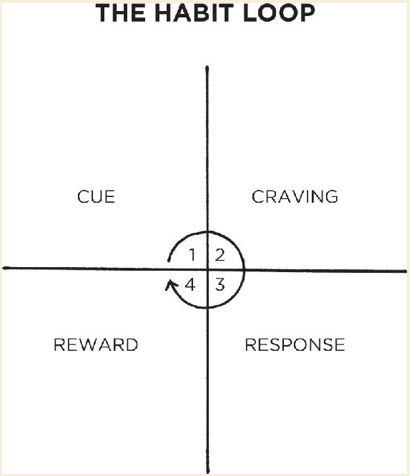
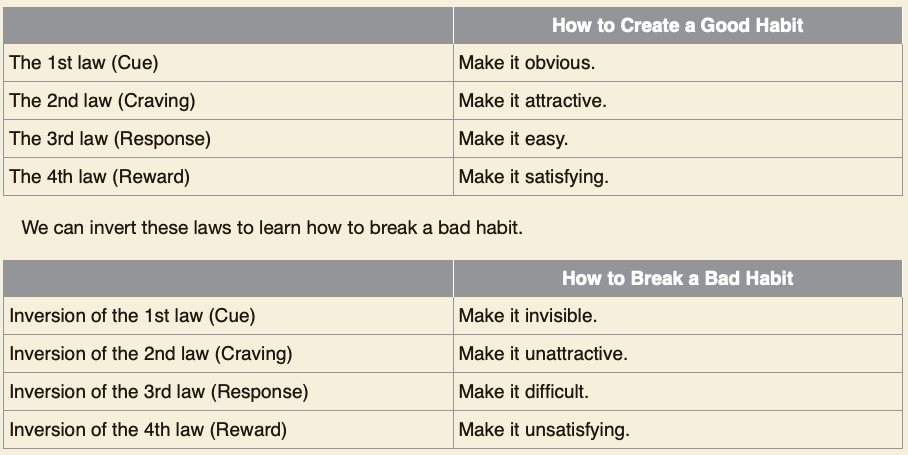
Whenever you want to change your behavior, you can simply ask yourself:
- How can I make it obvious?
- How can I make it attractive?
- How can I make it easy?
- How can I make it satisfying?
The 1st Law: Make It Obvious
4. The Man Who Didn’t Look Right
You don’t need to be aware of the cue for a habit to begin.
And the more you repeat these patterns, the less likely you become to question what you’re doing and why you’re doing it.
Before we can effectively build new habits, we need to get a handle on our current ones. This can be more challenging than it sounds because once a habit is firmly rooted in your life, it is mostly nonconscious and automatic. If a habit remains mindless, you can’t expect to improve it. As the psychologist Carl Jung said, “Until you make the unconscious conscious, it will direct your life and you will call it fate.”
The more automatic a behavior becomes, the less likely we are to consciously think about it. And when we’ve done something a thousand times before, we begin to overlook things. We assume that the next time will be just like the last. We’re so used to doing what we’ve always done that we don’t stop to question whether it’s the right thing to do at all. Many of our failures in performance are largely attributable to a lack of self-awareness.
One of our greatest challenges in changing habits is maintaining awareness of what we are actually doing. This helps explain why the consequences of bad habits can sneak up on us.
Create your Habits Scorecard. Make a list of your daily habits. Categorize your habits by how they will benefit you in the long run. (Does this behaviour help me become the type of person I wish to be?) The goal is to simply notice what is actually going on.
Try Pointing-and-Calling. Say out loud the action that you are thinking of taking and what the outcome will be. If you want to cut back on your junk food habit but notice yourself grabbing another cookie, say out loud, “I’m about to eat this cookie, but I don’t need it. Eating it will cause me to gain weight and hurt my health.” Pointing-and-Calling raises your level of awareness from a nonconscious habit to a more conscious level by verbalizing your actions.
Hearing your bad habits spoken aloud makes the consequences seem more real. It adds weight to the action rather than letting yourself mindlessly slip into an old routine. This approach is useful even if you’re simply trying to remember a task on your to-do list. Just saying out loud, “Tomorrow, I need to go to the post office after lunch,” increases the odds that you’ll actually do it. You’re getting yourself to acknowledge the need for action—and that can make all the difference.
5. The Best Way to Start a New Habit
Implementation intentions leverage the two most common cues: time and location.
Broadly speaking, the format for creating an implementation intention is:
“When situation X arises, I will perform response Y.”
People who make a specific plan for when and where they will perform a new habit are more likely to follow through. Many people think they lack motivation when what they really lack is clarity.
The simple way to apply this strategy to your habits is to fill out this sentence:
I will [BEHAVIOR] at [TIME] in [LOCATION].
- Meditation. I will meditate for one minute at 7 a.m. in my kitchen.
- Studying. I will study Spanish for twenty minutes at 6 p.m. in my bedroom.
- Exercise. I will exercise for one hour at 5 p.m. in my local gym.
There is another benefit to implementation intentions. Being specific about what you want and how you will achieve it helps you say no to things that derail progress, distract your attention, and pull you off course. We often say yes to little requests because we are not clear enough about what we need to be doing instead. When your dreams are vague, it’s easy to rationalize little exceptions all day long and never get around to the specific things you need to do to succeed.
Give your habits a time and a space to live in the world. The goal is to make the time and location so obvious that, with enough repetition, you get an urge to do the right thing at the right time, even if you can’t say why.
Habit Stacking: A Simple Plan to Overhaul Your Habits
One of the best ways to build a new habit is to identify a current habit you already do each day and then stack your new behavior on top. This is called habit stacking. Habit stacking is a special form of an implementation intention. Rather than pairing your new habit with a particular time and location, you pair it with a current habit.
The habit stacking formula is:
“After [CURRENT HABIT], I will [NEW HABIT].”
- Meditation. After I pour my cup of coffee each morning, I will meditate for one minute.
- Exercise. After I take off my work shoes, I will immediately change into my workout clothes.
- Gratitude. After I sit down to dinner, I will say one thing I’m grateful for that happened today.
- Safety. After I put on my running shoes, I will text a friend or family member where I am running and how long it will take.
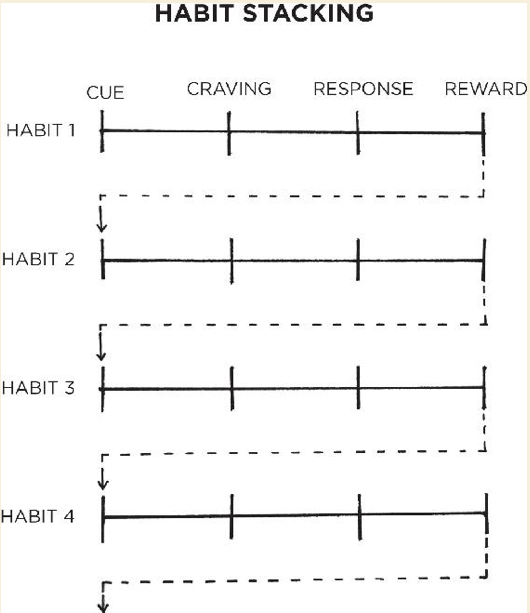
Your morning routine habit stack might look like this:
- After I pour my morning cup of coffee, I will meditate for sixty seconds.
- After I meditate for sixty seconds, I will write my to-do list for the day.
- After I write my to-do list for the day, I will immediately begin my first task.
Wirte down a list of habits that you do each day without fail (Get up, Eat breakfast) and a list of things that happen to you each day without fail (The sun rises). Armed with these two lists, you can begin searching for the best place to layer your new habit into your lifestyle.
Habit stacking works best when the cue is highly specific and immediately actionable.
“When I take a break for lunch, I will do ten push-ups.” Before or after lunch? Where to do them?
“When I close my laptop for lunch, I will do ten push-ups next to my desk.” Ambiguity gone.
6. Motivation is Overrated: Environment Often Matters More
People often choose products not because of what they are, but because of where they are. The more obviously available a product or service is, the more likely you are to try it.
Given that we are more dependent on vision than on any other sense, it should come as no surprise that visual cues are the greatest catalyst of our behavior. For this reason, a small change in what you see can lead to a big shift in what you do.
How to Design Your Environment For Success
Environment design is powerful not only because it influences how we engage with the world but also because we rarely do it. Most people live in a world others have created for them. Environment design allows you to take back control and become the architect of your life.
The Context is the Cue
Stop thinking about your environment as filled with objects. Start thinking about it as filled with relationships. Think in terms of how you interact with the spaces around you. For one person, her couch is the place where she reads for an hour each night. For someone else, the couch is where he watches television and eats a bowl of ice cream after work.
It is easier to build new habits in a new environment because you are not fighting against old cues.
But when you step outside your normal environment, you leave your behavioral biases behind. You aren’t battling old environmental cues, which allows new habits to form without interruption.
Create a separate space for work, study, exercise, entertainment, and cooking. The mantra I find useful is “One space, one use.”
Let my brain learn that bed is only associated with sleep. If I cannot fall asleep, go somewhere else till I am tired enough to sleep.
Whenever possible, avoid mixing the context of one habit with another. When you start mixing contexts, you’ll start mixing habits—and the easier ones will usually win out. This is one reason why the versatility of modern technology is both a strength and a weakness.
If your space is limited, divide your room into activity zones: a chair for reading, a desk for writing, a table for eating. You can do the same with your digital spaces. Every habit should have a home.
Focus comes automatically when you are sitting at your work desk. Relaxation is easier when you are in a space designed for that purpose. Sleep comes quickly when it is the only thing that happens in your bedroom. If you want behaviors that are stable and predictable, you need an environment that is stable and predictable.
7. The Secret to Self-Control
Here’s the punch line: You can break a habit, but you’re unlikely to forget it. And that means that simply resisting temptation is an ineffective strategy. It is hard to maintain a Zen attitude in a life filled with interruptions. It takes too much energy. In the short-run, you can choose to overpower temptation. In the long-run, we become a product of the environment that we live in. To put it bluntly, I have never seen someone consistently stick to positive habits in a negative environment.
A more reliable approach is to cut bad habits off at the source.
Self-control is a short-term strategy, not a long-term one.
Make the cues of your good habits obvious and the cues of your bad habits invisible.
People with high self-control tend to spend less time in tempting situations. It’s easier to avoid temptation than resist it.
The 2nd Law: Make It Attractive
8. How to Make a Habit Irresistible
Humans are also prone to fall for exaggerated versions of reality.
Society is filled with highly engineered versions of reality that are more attractive than the world our ancestors evolved in. They exaggerate features that are naturally attractive to us, and our instincts go wild as a result, driving us into excessive shopping habits, social media habits, porn habits, eating habits, and many others.
The Dopamine-Driven Feedback Loop
The ability to experience pleasure remained, but without dopamine, desire died. And without desire, action stopped.
Dopamine is released not only when you experience pleasure, but also when you anticipate it. It is the anticipation of a reward—not the fulfillment of it—that gets us to take action.
Your brain has far more neural circuitry allocated for wanting rewards than for liking them.
How to Use Temptation Bundling to Make Your Habits More Attractive
Temptation bundling works by linking an action you want to do with an action you need to do. In Byrne’s case, he bundled watching Netflix (the thing he wanted to do) with riding his stationary bike (the thing he needed to do).
You’re more likely to find a behavior attractive if you get to do one of your favorite things at the same time.
I can bundle eating with listening to podcast.
The habit stacking + temptation bundling formula is:
- After [CURRENT HABIT], I will [HABIT I NEED].
- After [HABIT I NEED], I will [HABIT I WANT].
9. The Role of Family and Friends in Shaping Your Habits
The story about chess player family in Hungary is amazing and motivating.
The Seductive Pull of Social Norms
We don’t choose our earliest habits, we imitate them. We follow the script handed down by our friends and family, our church or school, our local community and society at large. Behaviors are attractive when they help us fit in.
We imitate the habits of three groups in particular:
- The close.
- The many.
- The powerful.
1. Imitating the Close
We pick up habits from the people around us. We copy the way our parents handle arguments, the way our peers flirt with one another, the way our coworkers get results.
As a general rule, the closer we are to someone, the more likely we are to imitate some of their habits. Our friends and family provide a sort of invisible peer pressure that pulls us in their direction.
Think about how my family and roommates affect me invisiably. Eating habits, sleeping habits, reading habits.
One of the most effective things you can do to build better habits is to join a culture where your desired behavior is the normal behavior. New habits seem achievable when you see others doing them every day. If you are surrounded by fit people, you’re more likely to consider working out to be a common habit.
Your culture sets your expectation for what is “normal.” Surround yourself with people who have the habits you want to have yourself. You’ll rise together.
Join a culture where
- your desired behavior is the normal behavior
- you already have something in common with the group.
Change becomes more appealing because it feels like something people like you already do.
Nothing sustains motivation better than belonging to the tribe. It transforms a personal quest into a shared one. The shared identity begins to reinforce your personal identity. This is why remaining part of a group after achieving a goal is crucial to maintaining your habits. It’s friendship and community that embed a new identity and help behaviors last over the long run.
2. Imitating the Many
Whenever we are unsure how to act, we look to the group to guide our behavior. We are constantly scanning our environment and wondering, “What is everyone else doing?” We check reviews on Amazon or Yelp or TripAdvisor because we want to imitate the “best” buying, eating, and travel habits.
The normal behavior of the tribe often overpowers the desired behavior of the individual. The reward of being accepted is often greater than the reward of winning an argument, looking smart, or finding truth. Most days, we’d rather be wrong with the crowd than be right by ourselves.
You can override it—you can choose to ignore the group or to stop caring what other people think—but it takes work. Running against the grain of your culture requires extra effort.
3. Imitating the Powerful
Many of our daily habits are imitations of people we admire. You borrow the storytelling strategies of your favorite writer. You mimic the communication style of your boss. We imitate people we envy.
High-status people enjoy the approval, respect, and praise of others. And that means if a behavior can get us approval, respect, and praise, we find it attractive.
Ask myself: what would the person that I admire do in such a scenario?
Chapter Summary
- The culture we live in determines which behaviors are attractive to us.
- We tend to adopt habits that are praised and approved of by our culture because we have a strong desire to fit in and belong to the tribe.
- We tend to imitate the habits of three social groups: the close (family and friends), the many (the tribe), and the powerful (those with status and prestige).
- One of the most effective things you can do to build better habits is to join a culture where (1) your desired behavior is the normal behavior and (2) you already have something in common with the group.
- The normal behavior of the tribe often overpowers the desired behavior of the individual. Most days, we’d rather be wrong with the crowd than be right by ourselves.
- If a behavior can get us approval, respect, and praise, we find it attractive.
10. How to Find and Fix the Causes of Your Bad Habits
Where Cravings Come From
Every behavior has a surface level craving and a deeper, underlying motive. A craving is just a specific manifestation of a deeper underlying motive. Your brain did not evolve with a desire to smoke cigarettes or to check Instagram or to play video games. At a deep level, you simply want to reduce uncertainty and relieve anxiety, to win social acceptance and approval, or to achieve status.
Some of our underlying motives include:
- Conserve energy
- Obtain food and water
- Find love and reproduce
- Connect and bond with others
- Win social acceptance and approval
- Reduce uncertainty
Your habits are modern-day solutions to ancient desires.
Here’s the powerful part: there are many different ways to address the same underlying motive. Your current habits are not necessarily the best way to solve the problems you face; they are just the methods you learned to use.
The true motive of watching Youtube videos is to reduce stress. To solve this problem, there are better ways. For example, jump and dance outside the bedroom, away from the computer, for 5 minutes. (Don’t make it too hard to do.)
How to Reprogram Your Brain to Enjoy Hard Habits
You can make hard habits more attractive if you can learn to associate them with a positive experience. Sometimes, all you need is a slight mind-set shift.
You have to wake up early for work. You have to cook dinner for your family.
You get to wake up early for work. You get to cook dinner for your family.
burdens -> opportunities
The key point is that both versions of reality are true. You have to do those things, and you also get to do them.
Reframing your habits to highlight their benefits rather than their drawbacks is a fast and lightweight way to reprogram your mind and make a habit seem more attractive.
Build a list of things that I can switch viewpoint.
Create a motivation ritual by doing something you enjoy immediately before a difficult habit.
Associate working and reading with 1 minute of deep breath before hand or listening to music (with things that will make you truly happy), then with enough repetition, my concentration will go up just by taking deep breath for 1 minute or by putting up headphones. In this case, breath or headphones become the cue that means concentration.
The 3rd Law: Make It Easy
11. Walk Slowly, but Never Backward
As Voltaire once wrote, “The best is the enemy of the good.”
The two ideas sound similar, but they’re not the same. When you’re in motion, you’re planning and strategizing and learning. Those are all good things, but they don’t produce a result. Action, on the other hand, is the type of behavior that will deliver an outcome.
The most effective form of learning is practice, not planning.
Motion makes you feel like you’re getting things done. But really, you’re just preparing to get something done.
If you want to master a habit, the key is to start with repetition, not perfection. You don’t need to map out every feature of a new habit. You just need to practice it.
I set aside my research and read this book. This is then motion, not action. The right thing is: do research, spare some time to read this book, pay attention to the habits when doing research, and use this book to guide correct the bad habits and establish new ones.
How Long Does it Actually Take to Form a New Habit?
Habits form based on frequency, not time.
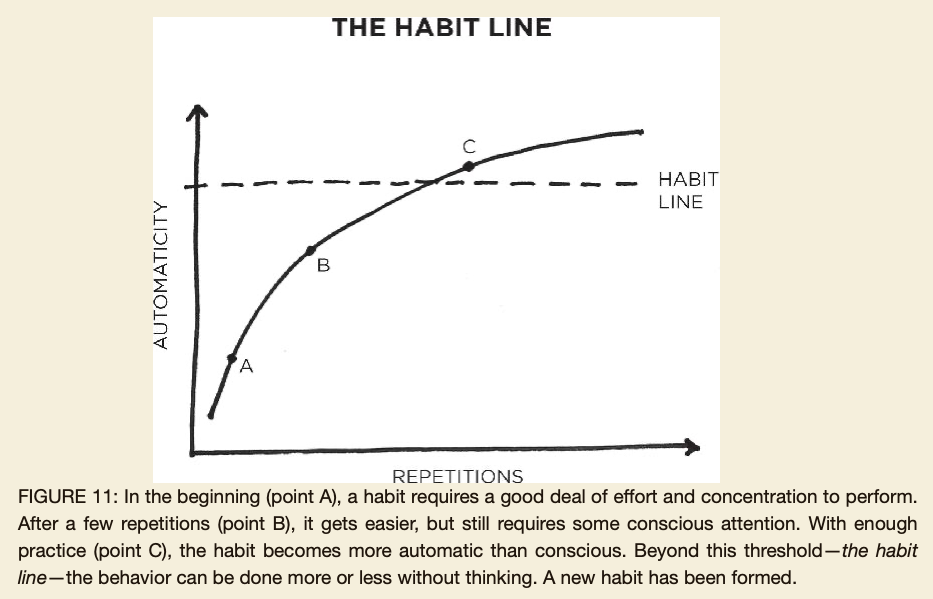
The same applie for learning. I can be good at math so long as I devote enough effort to train myself and practice.
12. The Law of Least Effort
The truth is, our real motivation is to be lazy and to do what is convenient.
Energy is precious, and the brain is wired to conserve it whenever possible. It is human nature to follow the Law of Least Effort. The less energy a habit requires, the more likely it is to occur.
In a sense, every habit is just an obstacle to getting what you really want. You don’t actually want the habit itself. What you really want is the outcome the habit delivers.
The idea behind make it easy is not to only do easy things. The idea is to make it as easy as possible in the moment to do things that payoff in the long run.
How to Achieve More with Less Effort
One of the most effective ways to reduce the friction associated with your habits is to practice environment design.
The Japanese companies looked for every point of friction in the manufacturing process and eliminated it. As they subtracted wasted effort, they added customers and revenue. Similarly, when we remove the points of friction that sap our time and energy, we can achieve more with less effort.
The central idea is to create an environment where doing the right thing is as easy as possible.
Reduce the friction associated with our good habits and increase the friction associated with our bad ones.
“Jump and run for 5 minutes during small breaks.” This practice is very useful to me.
Prime the Environment for Future Use
By priming the environment for future use, we reduce the friction of doing things that are good in the long run.
- Want to draw more? Put your pencils, pens, notebooks, and drawing tools on top of your desk, within easy reach.
- Want to exercise? Set out your workout clothes, shoes, gym bag, and water bottle ahead of time.
- Put my journal book on my bed, so everytime I plan to go to bed, I will see it and then write daily summary.
- Put the scale in the bathroom before going to bed, so every morning I will see it immediately when I get up. See the scale -> Do morning exercise -> Measure my weight. This chain of cues and actions can be seen as my ritual for starting a new day.
- Open To-Do everytime before letting the laptop sleep, so that everytime I wake it up, I remind myself what to do today.
If you find yourself watching too much television, unplug it and take the batteries out of the remote after each use. And if you’re really hard-core, move the television out of the living room and into a closet after each use. You can be sure you’ll only take it out when you really want to watch something.
For me, I use Cold Tukey to block Youtube and Bilibili websites on my Macbook Pro. If I want to watch it, I have to get out my Macbook Air from the bottom of closet, find out the charger and hdmi cable, and plug in the new cable. To push myself harder, I have to recite an article before I can touch the Macbook.
“How can we design a world where it’s easy to do what’s right?”
13. How to Stop Procrastination by Using the Two-Minute Rule
Decisive moments set the options available to your future self.
Take the first step, the others follow naturally. Establish a chain whose first step is easy and small.
The Two-minute Rule
Count your tendency to start big. Keep this in mind, always.
Even when you know you should start small, it’s easy to start too big. When you dream about making a change, excitement inevitably takes over and you end up trying to do too much too soon.
“When you start a new habit, it should take less than two minutes to do.”
- “Read before bed each night” –> “Read one page.”
- “Do thirty minutes of yoga” –> “Take out my yoga mat.”
- “Study for class” –> “Open my notes.”
- “Fold the laundry” –> “Fold one pair of socks.”
- “Run three miles” –> “Tie my running shoes.”
Once you’ve started doing the right thing, it is much easier to continue doing it. A new habit should not feel like a challenge. The actions that follow can be challenging, but the first two minutes should be easy. Find a “gateway habit”.
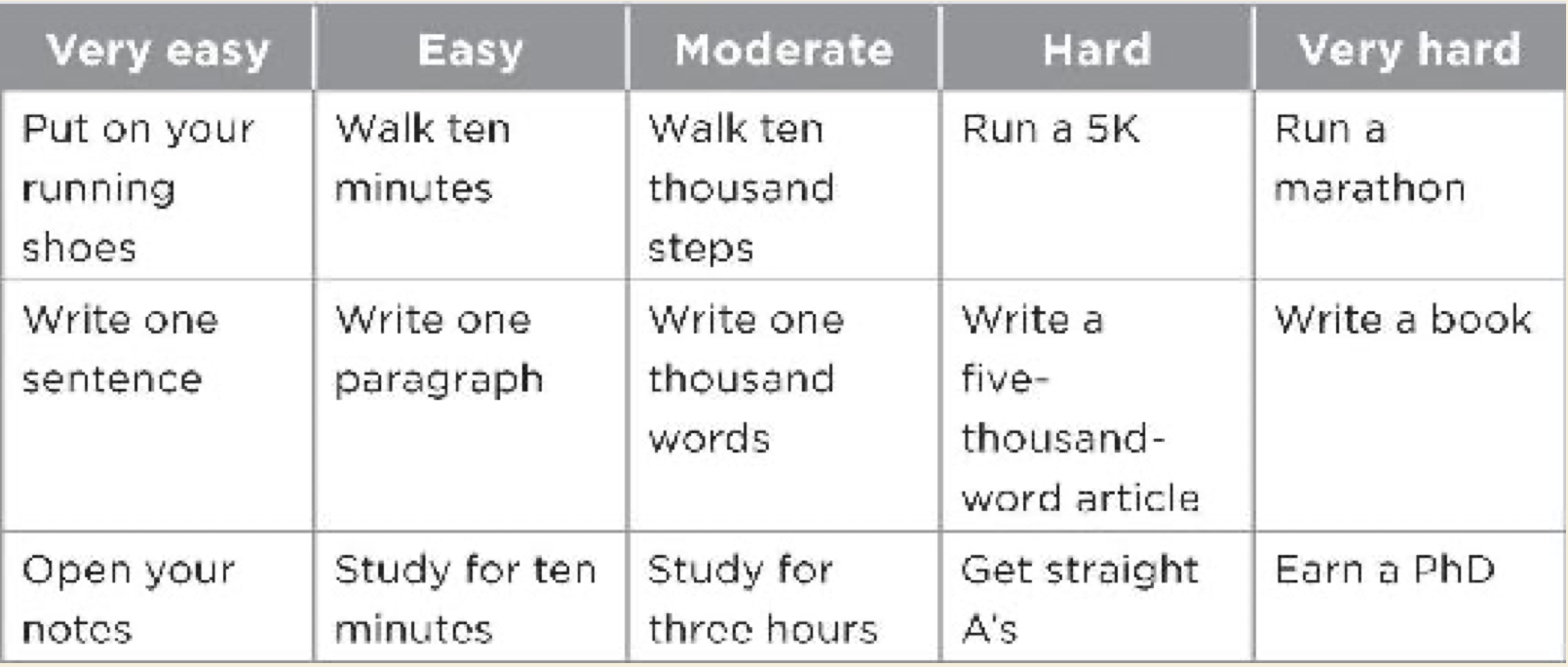
The point is not to do one thing. The point is to master the habit of showing up. The truth is, a habit must be established before it can be improved. If you can’t learn the basic skill of showing up, then you have little hope of mastering the finer details.
As you master the art of showing up, the first two minutes simply become a ritual at the beginning of a larger routine. The more you ritualize the beginning of a process, the more likely it becomes that you can slip into the state of deep focus that is required to do great things.
Try the following. Forget about the goal of losing weight. Go to the gym everyday, but just stay for 5 minutes and leave as soon as the time is up. Repeat for two months. Then you may think maybe I can stay a bit longer. The gateway is to stay in the gym for 5 minutes and don’t think about the end goal.
As for reading, I can now try the following. Read two pages of a paper and stop. Just two pages. Repeat everyday. Master the habit of showing up in front of papers.
On one hand, we are ritualizing the beginning of a process. On the other hand, we are reinforcing the identity we want to build.
You’re not worried about getting in shape. You’re focused on becoming the type of person who doesn’t miss workouts. You’re taking the smallest action that confirms the type of person you want to be.
The secret is to always stay below the point where it feels like work.
At some point, once you’ve established the habit and you’re showing up each day, you can combine the Two-Minute Rule with a technique we call habit shaping to scale your habit back up toward your ultimate goal. Focus on just the first two minutes and master that stage before moving on to the next level.
14. How to Make Good Habits Inevitable and Bad Habits Impossible
A commitment device is a choice you make in the present that controls your actions in the future. Commitment devices increase the odds that you’ll do the right thing in the future by making bad habits difficult in the present.
To prevent overeating, I put all that I am going to eat inside a bowl and the rest in the fridge. Just telling myself “I’ll just eat these” will never work.
Similarly, I use Cold Tukey to help me be focused. And I silence the notification of apps except phone calls.
If you’re feeling motivated to get in shape, schedule a yoga session and pay ahead of time.
How to Automate a Habit and Never Think About it Again
The best way to break a bad habit is to make it impractical to do. Increase the friction until you don’t even have the option to act.
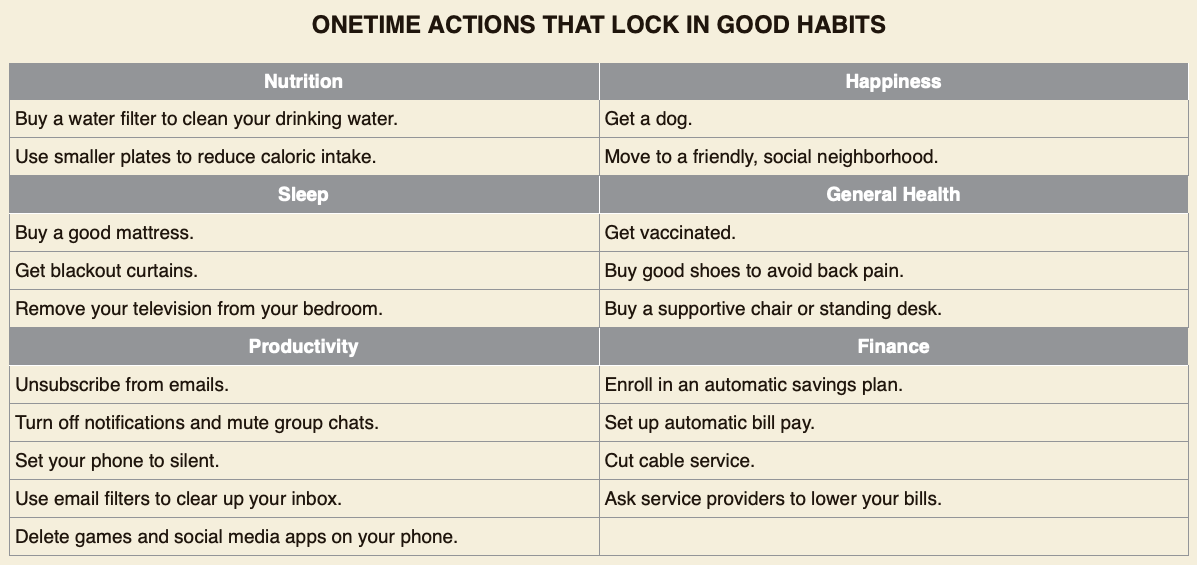
Use technology to automize some work for us. But don’t let them take control over us.
The downside of automation is that we can find ourselves jumping from easy task to easy task without making time for more difficult, but ultimately more rewarding, work.
After I removed the mental candy from my environment, it became much easier to eat the healthy stuff.
It is the ultimate way to lock in future behavior rather than relying on willpower in the moment. By utilizing commitment devices, strategic onetime decisions, and technology, you can create an environment of inevitability—a space where good habits are not just an outcome you hope for but an outcome that is virtually guaranteed.
The 4th Law: Make It Satisfying
15. The Cardinal Rule of Behavior Change
“This feels good. Do this again, next time.” Pleasure teaches your brain that a behavior is worth remembering and repeating.
The Cardinal Rule of Behavior Change:
- What is rewarded is repeated.
- What is punished is avoided.
The first three laws of behavior change—make it obvious, make it attractive, and make it easy—increase the odds that a behavior will be performed this time. The fourth law of behavior change—make it satisfying—increases the odds that a behavior will be repeated next time.
The Mismatch between Immediate and Delayed Rewards
Modern society is a delayed-return environment, and the human brain hasn’t evolve accordingly. We tend to prefer quick payoffs to long-term ones. We prefer instant gratification.
Put another way, the costs of your good habits are in the present. The costs of your bad habits are in the future.
We all want better lives for our future selves. However, when the moment of decision arrives, instant gratification usually wins. You are no longer making a choice for Future You, who dreams of being fitter or wealthier or happier. You are choosing for Present You, who wants to be full, pampered, and entertained. As a general rule, the more immediate pleasure you get from an action, the more strongly you should question whether it aligns with your long-term goals.
Update the Cardinal Rule of Behavior Change:
- What is immediately rewarded is repeated.
- What is immediately punished is avoided.
How to Turn Instant Gratification to Your Advantage
Reinforcement ties your habit to an immediate reward, which makes it satisfying when you finish.
Immediate reinforcement can be especially helpful when dealing with habits of avoidance, which are behaviors you want to stop doing. It can be hard to feel satisfied when there is no action in the first place. All you’re doing is resisting temptation, and there isn’t much satisfying about that.
Make avoidance visible.
Whenever I pass on a purchase, put the same amount of money into my investment account.
It is worth noting that it is important to select short-term rewards that reinforce your identity rather than ones that conflict with it. If your reward for exercising is eating a bowl of ice cream, then you’re casting votes for conflicting identities, and it ends up being a wash. Instead, maybe your reward is a massage, which is both a luxury and a vote toward taking care of your body.
Eventually, as intrinsic rewards like a better mood, more energy, and reduced stress kick in, you’ll become less concerned with chasing the secondary reward. The identity itself becomes the reinforcer.
16. How to Stick with Good Habits Every Day
Making progress is satisfying, and visual measures—like moving paper clips or hairpins or marbles—provide clear evidence of your progress.
How to Keep Your Habits on Track
A habit tracker is a simple way to measure whether you did a habit.
Habit tracking
- Obvious: creates a visual cue that can remind you to act
- Attractive: is inherently motivating because you see the progress you are making and don’t want to lose it
- Satisfying: feels satisfying whenever you record another successful instance of your habit.
- provides visual proof that you are casting votes for the type of person you wish to become.
Many people resist the idea of tracking and measuring. It can feel like a burden because it forces you into two habits: the habit you’re trying to build and the habit of tracking it.
Record each measurement immediately after the habit occurs.
The habit stacking + habit tracking formula is:
After [CURRENT HABIT], I will [TRACK MY HABIT].
I set up a habit tracker using Microsoft To Do, and now I track three habits: (1) get up before 6:30 am; (2) do morning exercise; (3) read 2 pages of research paper. The finish sound of each task is satisfying and will give me immediate reward.
How to Recover Quickly When Your Habits Break Down
No matter how consistent you are with your habits, it is inevitable that life will interrupt you at some point. Perfection is not possible. Whenever this happens to me, I try to remind myself of a simple rule: never miss twice.
Missing once is an accident. Missing twice is the start of a new habit.
Too often, we fall into an all-or-nothing cycle with our habits. The problem is not slipping up; the problem is thinking that if you can’t do something perfectly, then you shouldn’t do it at all.
You don’t realize how valuable it is to just show up on your bad (or busy) days. Lost days hurt you more than successful days help you. If you start with $100, then a 50 percent gain will take you to $150. But you only need a 33 percent loss to take you back to $100. In other words, avoiding a 33 percent loss is just as valuable as achieving a 50 percent gain.
This is why the “bad” workouts are often the most important ones. Sluggish days and bad workouts maintain the compound gains you accrued from previous good days. Simply doing something—ten squats, five sprints, a push-up, anything really—is huge. Don’t put up a zero. Don’t let losses eat into your compounding.
Furthermore, it’s not always about what happens during the workout. It’s about being the type of person who doesn’t miss workouts. It’s easy to train when you feel good, but it’s crucial to show up when you don’t feel like it—even if you do less than you hope.
When I wake up feeling tired in the morning and worry that I may not be effective in studying, I still get up before 6:30 am, even if I will read a few chapters of funny story books or just walk outside. It reaffirms my identity of an early riser.
When I feel tired and don’t want to read papers, I still open Mendeley and take out notebooks. Write down something, even I may not fully understand or remember them.
Don’t get trapped by the all-or-nothing cycle. Every bit adds up. And every missing costs a lot.
Knowing When (and When Not) to Track a Habit
The dark side of tracking a particular behavior is that we become driven by the number rather than the purpose behind it.
The human mind wants to “win” whatever game is being played.
We focus on working long hours instead of getting meaningful work done. We care more about getting ten thousand steps than we do about being healthy. We teach for standardized tests instead of emphasizing learning, curiosity, and critical thinking. In short, we optimize for what we measure. When we choose the wrong measurement, we get the wrong behavior.
Focus on the big picture and the overall system.
Measurement is only useful when it guides you and adds context to a larger picture, not when it consumes you.
In our data-driven world, we tend to overvalue numbers and undervalue anything ephemeral, soft, and difficult to quantify. We mistakenly think the factors we can measure are the only factors that exist. But just because you can measure something doesn’t mean it’s the most important thing. And just because you can’t measure something doesn’t mean it’s not important at all.
The rule applies to NLP as well. High evaluation metrics don’t mean a better understanding of natural languages.
Currently, I don’t have a clear idea about measuring my improvement, both in life and in study. Will remind myself of such a potential pitfall in the process of establishing good habits.
17. How an Accountability Partner Can Change Everything
Pain is an effective teacher. When the consequences are severe, people learn quickly.
The more immediate the pain, the less likely the behavior. Adding an instant cost to the action is a great way to reduce their odds.
If you’re going to rely on punishment to change behavior, then the strength of the punishment must match the relative strength of the behavior it is trying to correct. To be productive, the cost of procrastination must be greater than the cost of action. To be healthy, the cost of laziness must be greater than the cost of exercise.
Behavior only shifts if the punishment is painful enough and reliably enforced.
The Habit Contract
A habit contract is a verbal or written agreement in which you state your commitment to a particular habit and the punishment that will occur if you don’t follow through. Then you find one or two people to act as your accountability partners and sign off on the contract with you.
An accountability partner can create an immediate cost to inaction. We care deeply about what others think of us, and we do not want others to have a lesser opinion of us.
A habit contract can be used to add a social cost to any behavior. It makes the costs of violating your promises public and painful.
Honestly, when reading the example habit contracts, my initial reaction was that such contracts were too harsh. But only with punishemnt that is painful enough will the contract be truly beneficial in the long run.
Do I have the courage to do the same thing? Yes, I do!
But Harris convinced me that signing the contract was an indication of seriousness. “Anytime I skip this part,” he said, “I start slacking almost immediately.”
Make the contract formal and have it signed on paper, not just digitally. Make the cost of violating your promises painful and disturbing.
Yu’s Habit Contract Many thanks to two friends: Xuesong Hou and Chunlin Lin. They are my accountability partners.
Advanced Tactics: How to Go from Being Merely Good to Being Truly Great
18. The Truth About Talent (When Genes Matter and When They Don’t)
Genes do not determine your destiny. They determine your areas of opportunity.
How Your Personality Influences Your Habits
“Big Five” personality traits
- Openness to experience: from curious and inventive on one end to cautious and consistent on the other.
- Conscientiousness: organized and efficient to easygoing and spontaneous.
- Extroversion: outgoing and energetic to solitary and reserved (you likely know them as extroverts vs. introverts).
- Agreeableness: friendly and compassionate to challenging and detached.
- Neuroticism: anxious and sensitive to confident, calm, and stable.
The takeaway is that you should build habits that work for your personality. You don’t have to build the habits everyone tells you to build. Choose the habit that best suits you, not the one that is most popular.
How to Find a Game Where the Odds are in Your Favor
explore/exploit trade-off
In the beginning of a new activity, there should be a period of exploration. The goal is to try out many possibilities, research a broad range of ideas, and cast a wide net. After this initial period of exploration, shift your focus to the best solution you’ve found—but keep experimenting occasionally. The proper balance depends on whether you’re winning or losing.
In the long-run it is probably most effective to work on the strategy that seems to deliver the best results about 80 to 90 percent of the time and keep exploring with the remaining 10 to 20 percent.
- What feels like fun to me, but work to others? The mark of whether you are made for a task is not whether you love it but whether you can handle the pain of the task easier than most people.
- What makes me lose track of time?
- Where do I get greater returns than the average person? We are continually comparing ourselves to those around us, and a behavior is more likely to be satisfying when the comparison is in our favor.
- What comes naturally to me? No internal judgments or people-pleasing. Whenever you feel authentic and genuine, you are headed in the right direction.
To be honest, some of this process is just luck. We all have limited time on this planet, and the truly great among us are the ones who not only work hard but also have the good fortune to be exposed to opportunities that favor us.
When you can’t win by being better, you can win by being different. By combining your skills, you reduce the level of competition, which makes it easier to stand out. You can shortcut the need for a genetic advantage (or for years of practice) by rewriting the rules. A good player works hard to win the game everyone else is playing. A great player creates a new game that favors their strengths and avoids their weaknesses.
Even if you’re not the most naturally gifted, you can often win by being the best in a very narrow category.
How to Get the Most out of Your Genes
Our genes do not eliminate the need for hard work. They clarify it. They tell us what to work hard on.
Pick behaviors that align with your personality and skills.
19. The Goldilocks Rule: How to Stay Motivated in Life and Work
The Goldilocks Rule states that humans experience peak motivation when working on tasks that are right on the edge of their current abilities. Not too hard. Not too easy. Just right.
When too hard, we tend to give up easily; when too easy, we tend to get bored quickly.
Work on challenges that are on the perimeter of our ability. As we make progress, continue to advance the difficulty in small ways, and still, on the edge of our improved ability.
How to Stay Focused When You Get Bored Working on Your Goals
“At some point it comes down to who can handle the boredom of training every day, doing the same lifts over and over and over.”
Mastery requires practice. But the more you practice something, the more boring and routine it becomes. Once the beginner gains have been made and we learn what to expect, our interest starts to fade. Sometimes it happens even faster than that. It’s easy to rationalize taking a day off because you’re in a good place.
The greatest threat to success is not failure but boredom. We get bored with habits because they stop delighting us. And as our habits become ordinary, we start derailing our progress to seek novelty.
We can utilize the Goldilocks rule to help keep things engaging, but no habit will stay interesting forever.
You have to fall in love with boredom. I can guarantee that if you manage to start a habit and keep sticking to it, there will be days when you feel like quitting. But stepping up when it’s annoying or painful or draining to do so, that’s what makes the difference between a professional and an amateur.
When a habit is truly important to you, you have to be willing to stick to it in any mood.
There have been a lot of days I’ve felt like relaxing, but I’ve never regretted showing up and working on something that was important to me.
I don’t want to be a fair-weather student, and I will not be.
Professionals stick to the schedule; amateurs let life get in the way.
20. The Downside of Creating Good Habits
The upside of habits is that we can do things without thinking. The downside of habits is that you get used to doing things a certain way and stop paying attention to little errors. You assume you’re getting better because you’re gaining experience. In reality, you are merely reinforcing your current habits—not improving them.
Habits are necessary, but not sufficient for mastery. What you need is a combination of automatic habits and deliberate practice.
Habits + Deliberate Practice = Mastery
Mastery is the process of narrowing your focus to a tiny element of success, repeating it until you have internalized the skill, and then using this new habit as the foundation to advance to the next frontier of your development.
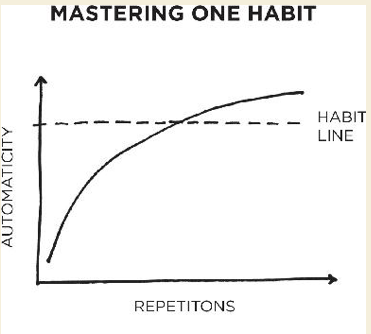 | 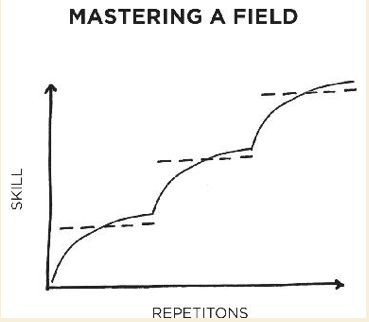 |
It is precisely at the moment when you begin to feel like you have mastered a skill—right when things are starting to feel automatic and you are becoming comfortable—that you must avoid slipping into the trap of complacency.
How to Review Your Habits and Make Adjustments
Reflection and review enables the long-term improvement of all habits because it makes you aware of your mistakes and helps you consider possible paths for improvement.
The author of the book employ two modes of reflection and review: Annual Review on December and Integrity Report on June. The goal is to remind himself of the big picture and revisit the desired identity and see how his habits are helping him become the type of person he wants to be and how to upgrade the habits.
I set up my own version of reports as follows, one Annual Review(December), one Half-year Review(June).
- What went well in the past six months?
- What didn’t go so well in the past six months?
- What did I learn?
- What do I feel the happiest about? The most proud of?
- How can I set a higher standard in the future?
How to Break the Beliefs that Hold You Back
The more sacred an idea is to us—that is, the more deeply it is tied to our identity—the more strongly we will defend it against criticism. You see this in every industry. The schoolteacher who ignores innovative teaching methods and sticks with her tried-and-true lesson plans. The veteran manager who is committed to doing things “his way.” The surgeon who dismisses the ideas of her younger colleagues.
When you cling too tightly to one identity, you become brittle. Lose that one thing and you lose yourself. The key to mitigating these losses of identity is to redefine yourself such that you get to keep important aspects of your identity even if your particular role changes.
Life is constantly changing, so you need to periodically check in to see if your old habits and beliefs are still serving you.
Conclusion
Success is not a goal to reach or a finish line to cross. It is a system to improve, an endless process to refine.
The secret to getting results that last is to never stop making improvements. It’s remarkable what you can build if you just don’t stop.
Small habits don’t add up. They compound.
I am glad that I meet this book. I am now working actively following the advice in this book and feel much better about myself. I will review this blog every week to keep myself alert.
References
[1] Clear, James. Atomic habits: An easy & proven way to build good habits & break bad ones. Penguin, 2018.
